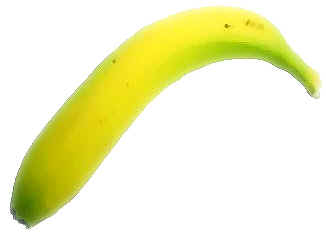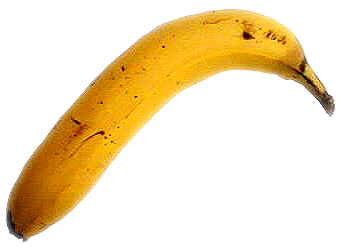Varieties
There are many varieties of cultivated Bananas, the two main varieties that are commercially grown are Cavendish and Gros Michel. The scientific name or identification for Gros Michel is Musa Sapientum and Musa Cavendishii for the Cavendish variety. The Cavendish is the more widely used variety as it is less susceptible to disease.
Gros Michel a large and vigorous plant it bears heavy, symmetrical bunches of 1 to 15 hands of large fruit, the fruits are bottlenecked with a tapered point, bright yellow when ripe and maintains its color, resistant to bruising, and ripens uniformly.
The Gros Michel appears to be a native in Burma, Thailand, Malaya, Indonesia and Ceylon. The Gros Mechel first appeared in the new world in Martinique early in the i9th century, possibly by a naval officer Baudin, who introduced numerous Asian Plants to the Botanic Garden at St. Pierre. It was known there as Figue Baudin and was taken from there to Jamaica in 1835 by Jean Francois Pouyat where it became known as the Pouyat or Martinique and then later known as Gros Michel. This variety was introduced in the Pacific around the turn of the century from Jamaica to Fiji in1891, Australia in 1910 and to Hawaii by way of Nicaragua in 1903.
The Cavendish similar to the Gros Michal young suckers are bright red, the fruit is greenish at ripeness, the fruit tips are blunt with immunity to the devastating Panama Disease. In the case of both varieties the fruit is 5 times longer than it is wide and markedly curved.
This variety requires special care to avoid bruising and advanced techniques to ripen evenly. The Dwarf Cavendish, a clone of the Cavendish, gets its name not from the fruit but from the height of the stalks and is used in cooler climates were its yields are very good.
Other types not seen in the U.S..
Lacatan has numerous related forms producing bunches of blunt-fingered fruit similar to Cavendish and with much of the same ripening characteristics
It is important to remember that as opposed to many other plant bananas do not ripen satisfactorily on the plant but can be ripened to optimum quality off the plant. This means that many suppliers may be right when they claim that fruit made available at distance points may have the same quality as those consumed at the production sight. Of course this has only been made possible by the advancements in harvesting, handling, packing, shipping, and ripening processes.
A good banana should be plump, unblemished, firm, and bright in appearance. The color is not always a sign of quality, in some cases a greenish banana may be of just as good quality as a fully yellow one, but not yet at the eating stage. Bananas may be ripened at room temperature but once ripe they can then be refrigerated but the skin may turn brown. On the other hand a green banana will be damaged by ordinary refrigeration. Once the ripening process has been halted in this matter it will not resume normal ripening when the temperature is raised.
Avoid fruit that is soft, or otherwise shows bruising by considerable discoloration.
Tree ripened bananas are not the most desirable as stated by the United fruit Co, " The truth is that no resident of the tropics eats bananas directly from the tree. He gathers the bunch at the same stage as the fruit is gathered for export, fully developed but green, then hangs it in a shady spot, and waits for it to ripen. He does this because experience has taught him that the majority of bananas, if left to ripen on the tree, split open and are attacked by insects which render the pulp unfit for eating, and that those which reach full ripeness without splitting have a pulp which has little flavor, is dry, and unpleasantly mealy in character".
No.1 consists of bananas of a yellow variety which have reached a stage of maturity which will insure satisfactory completion of the ripening process. They should be clean and bright, firm, well developed, and free from damage materially affecting appearance, shipping quality or edible quality caused by scars or other discoloration, decay, disease, chilling, heat, sunburn, sprayburn, chemicals, mechanical or other means. When bananas are in hands or cluster, the hands or clusters show a smooth cut where detached from the stalk and are free from portions the stalk. Each hand has 8 or more fingers, each cluster has 3 or more fingers. Unless otherwise specified, the maximum diameter of each banana shall not be less than 1 1/8 inches, and the length of each banana shall not be less than 6 inches, measured along the line of the outer curve from the blossom end of pulp.
|
Monthly Availability as a Percentage of Annual Production |
|||||
| Jan | Feb | Mar | Apr | May | June |
| % | % | % | % | % | % |
| 7.7 | 8 | 9.2 | 8.9 | 9.2 | 8.5 |
| July | Aug | Sept | Oct | Nov | Dec |
| % | % | % | % | % | % |
| 7.6 | 7.4 | 7.6 | 8.6 | 8.4 | 8.8 |
No.1,
Peel
color
green
No.2,
Light
green
No.3
Yellowish
green
No.4
Greenish
yellow
No
5
Yellow
with
green
tips
No.6
Yellow
No.7
Yellow,
freckled
with
brown
 |
 |
| No. 2 | No. 7 |
1
lb.
as
purchased
=0.68
ready
to
serve
1
medium
banana
=
2/3
cup
1
Lb.
=
3
portions
8.5
lb
=
25
portions
33.5
lbs.=
100
portions
4
oz.
mashed
portions
1
lb.=
2.72
portions
37
lbs.=
100
potions